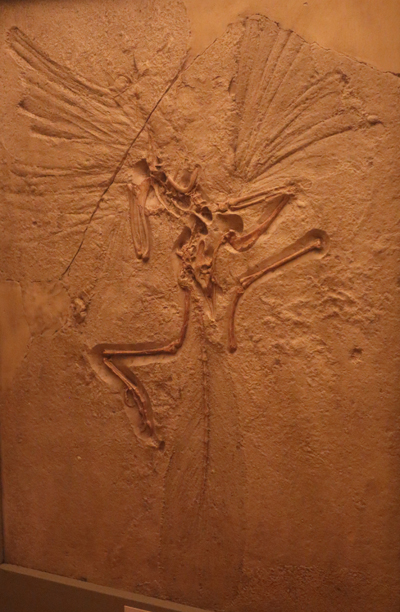“Maximum Likelihood” Study Suggests Archaeopteryx is a Bird and Not a Dinosaur
Archaeopteryx (A. lithographica) is perhaps one of the most studied species known. An amazing amount of research has been carried out on this creature, whose fossils are associated with lithographic limestone deposits in Germany. A few weeks ago, we reported that a study carried out by a team of Chinese scientists, in the light of a new theropod dinosaur discovery, placed Archaeopteryx in the Dinosauria and not with the Aves (birds). However, in a new study, this crow-sized, feathered creature has once again been defined as a primitive bird.
Archaeopteryx
The new research appearing this week in the scientific journal ” Biology Letters” has been carried out by evolutionary biologist, Dr Michael Lee of the University of Adelaide and the South Australian Museum and Dr Trevor Worthy of the University of New South Wales. These Australian based scientists contradict the findings of the Chinese team, from the Chinese Academy of Sciences, that only a few weeks ago placed Archaeopteryx in the dinosaur family tree.
A Fossil Cast of Archaeopteryx on Display at a Museum
Picture credit: Everything Dinosaur
The Chinese researchers compared the fossils of Archaeopteryx with those of a newly discovered non-avian, Chinese theropod dinosaur Xiaotingia zhengi. This newly discovered, fast-running, meat-eater is believed to be closely related to Archaeopteryx, but it was a non-flying, feathered dinosaur. This put into doubt the widely accepted scientific view that Archaeopteryx was one of the first birds to evolve.
To read more about this Chinese theropod and the implications for Archaeopteryx: Is Archaeopteryx about to be Knocked Off its Perch?
Commenting on the uproar and excitement caused when the first nearly complete fossil of Archaeopteryx was discovered 150 years ago, Dr Lee stated:
“It was immediately recognised as half bird-half reptile when it was first discovered.”
However, the discovery of X. zhengi led to the proposing of a new, remodelled evolutionary tree that placed Archaeopteryx in a group with bird-like dinosaurs such as the dromaeosaurs.
Summing up the implications for A. lithographica as a result of the new phylogenetic analysis, Dr Lee stated:
“Archaeopteryx lost its exalted place in bird evolution.”
The problem that concerned the Australian team, was that this new Chinese study placed the flying Archaeopteryx, an animal capable of sustained, powered flight in with a group of dinosaurs that were either ground dwelling, gliders or weak fliers that may not have flown in the same bird-like manner as Archaeopteryx.
Dr Lee commented that, it meant that bird flight most probably evolved more than once and Archaeopteryx possibly evolved flight independently of birds in a case of what’s called “convergent evolution”. As far as evolutionary theory goes, such scenarios are not particularly elegant. So Lee and his colleagues carried out a new analysis of the data to see what further analysis could reveal.
Classifying Archaeopteryx
Once the study had been concluded, the team discovered that Archaeopteryx had roughly the same number of traits as birds as it did with dinosaurs. Archaeopteryx may have been a transitional fossil in every sense of the word –
Dr Lee said:
“If you just count the number of traits it’s basically a 50:50 call.”
The traditional method of building an evolutionary trees, what amounts to a phylogenetic study, weighs each trait equally and tries to find a tree that fits the majority of them – a best fit scenario giving all traits equal weighting. For the Australian team, they considered this approach to be not the best plan of attack in this case because some traits are more reliable than others, because they evolve slowly and are more likely to be conserved through time.
Dr Lee explained, that for example, a back bone is likely to evolve just once, but a particular fur colour could evolve multiple times, and is thus a less reliable trait for building evolutionary trees. The Australian team used a statistical analysis technique called ‘maximum-likelihood’, which is used to build evolutionary trees based on genetic data and applied this methodology to the fossil data. This technique can determine the rate of evolution of different traits and gives extra weight to more reliable slow-evolving traits, in essence it provides a weighting so that more important, slowly evolving traits have a higher value in the analytical work.
The team found the bird traits in Archaeopteryx were more reliable than the dinosaur traits and when this weighting was taken into consideration. You get an evolutionary tree that restores Archaeopteryx to its original position as “first bird“.
He went onto state:
“It puts it [Archaeopteryx] back where people have always thought it belonged.”
The researchers comment that despite these findings, the exact position of Archaeopteryx in the evolutionary tree is hard to pin down because there’s a whole swarm of fossils that lie between dinosaurs and birds. However, the findings do suggest that the “maximum-likelihood” method is a useful tool for analysing the fossil record. The research team hope to use the same methodology to study in detail the evolutionary relationships between early mammals in a bid to help define more precisely the exact phylogenetic relationships between Mesozoic mammals.
To view models and replicas of Archaeopteryx and other prehistoric animals (whilst stocks last): Papo Prehistoric Animal Models.







Leave A Comment